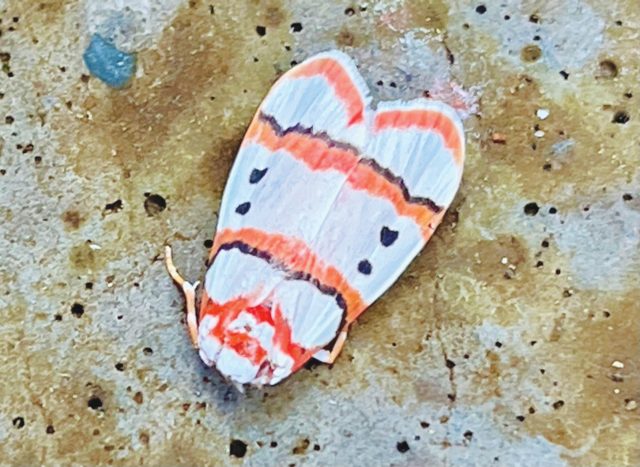 By Arun Kumar Singhal
By Arun Kumar Singhal
Spotted this beautiful, brightly coloured moth at home. Instantly, the hymn line from school times came rushing back: “All things bright and beautiful, all creatures great and small…” Possibly, in this black-and-white printing, you may not be able to see the moth in all its glory. But close your eyes and visualise it—bright orange, black and bluish white, delicate and radiant. I had never seen such a beautifully coloured moth before, and its appearance felt almost magical, like a tiny burst of wonder right at my doorstep. It was a fleeting moment, but one filled with meaning. Sometimes, the simplest encounters with nature remind us of truths that are easy to forget in our hurried lives.
The sight of a moth, wings patterned in delicate hues, is hardly a grand spectacle compared to the vast mountains or the rolling seas. Yet it carries with it a quiet poetry. A moth, after all, is not merely an insect—it is part of the intricate web of life, essential in its own way. Pollinating flowers in the night, serving as food for birds and bats, and enriching the soil through its life cycle, it holds a place in the larger design of creation. Its existence is a gentle reminder that every creature, no matter how small or overlooked, contributes to the balance of the natural world.
That hymn, learned in childhood, comes alive when we encounter such scenes. The words speak not just of beauty, but of gratitude and reverence. In saying “all creatures great and small”, it elevates every form of life—from the tiniest insect to the largest animal—into something sacred. In our modern age, we often rush past such details, but pausing to notice a moth resting on a wall or fluttering near a lamp can reconnect us to that sense of wonder.
Nature, in its diversity, does not seek our attention, yet it constantly offers lessons. A moth, fragile and fleeting in its lifespan, carries with it resilience. Emerging from a cocoon, it reminds us of transformation and the cycles of life. Its attraction to light, though puzzling to us, can also be seen as symbolic – drawn always toward brightness, toward hope, toward something beyond itself.
For many of us, childhood hymns or poems about nature planted the seeds of appreciation early on. Lines memorised in school halls resurface later in life, often unexpectedly, as guiding thoughts. They remind us that gratitude is not limited to grand occasions but is rooted in small, everyday encounters. A flower blooming in a crack, a bird’s call at dawn, the soft rustle of leaves, or the unexpected visit of a moth—all these moments call us to slow down, notice, and give thanks.
In a world increasingly shaped by speed, technology, and constant noise, these glimpses of nature are not luxuries but necessities. They steady us, ground us, and remind us of our place within a much larger whole. They awaken humility and foster reverence.
The colourful moth at my doorstep was more than just an insect; it was a messenger of sorts. It carried with it the hymn of childhood, the call to gratitude, and the gentle nudge to marvel at creation. Truly, the words echo with renewed meaning: “All things bright and beautiful, all creatures great and small…” And perhaps, in remembering, we find ourselves a little more connected, a little more thankful, and a little more alive to the wonders around us.
(Arun Kumar Singhal has been a resident of Doon for over five decades and is a quiet nature lover.)








